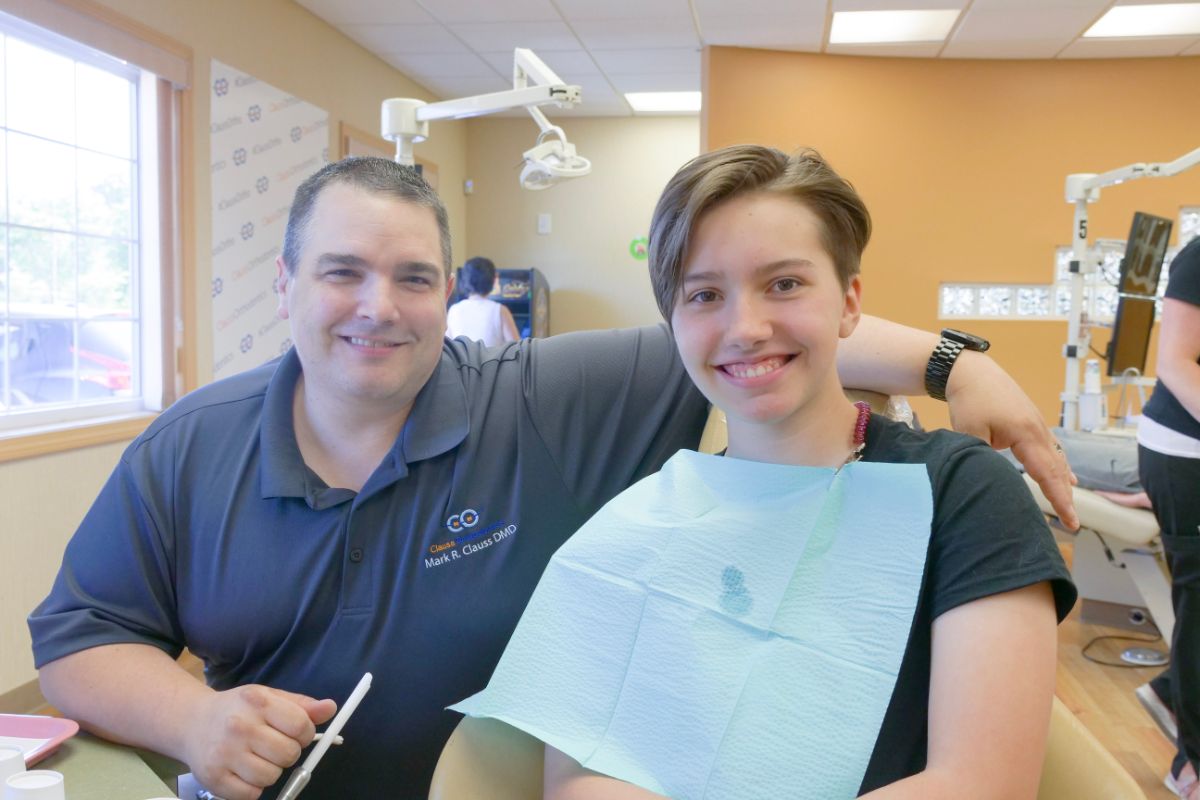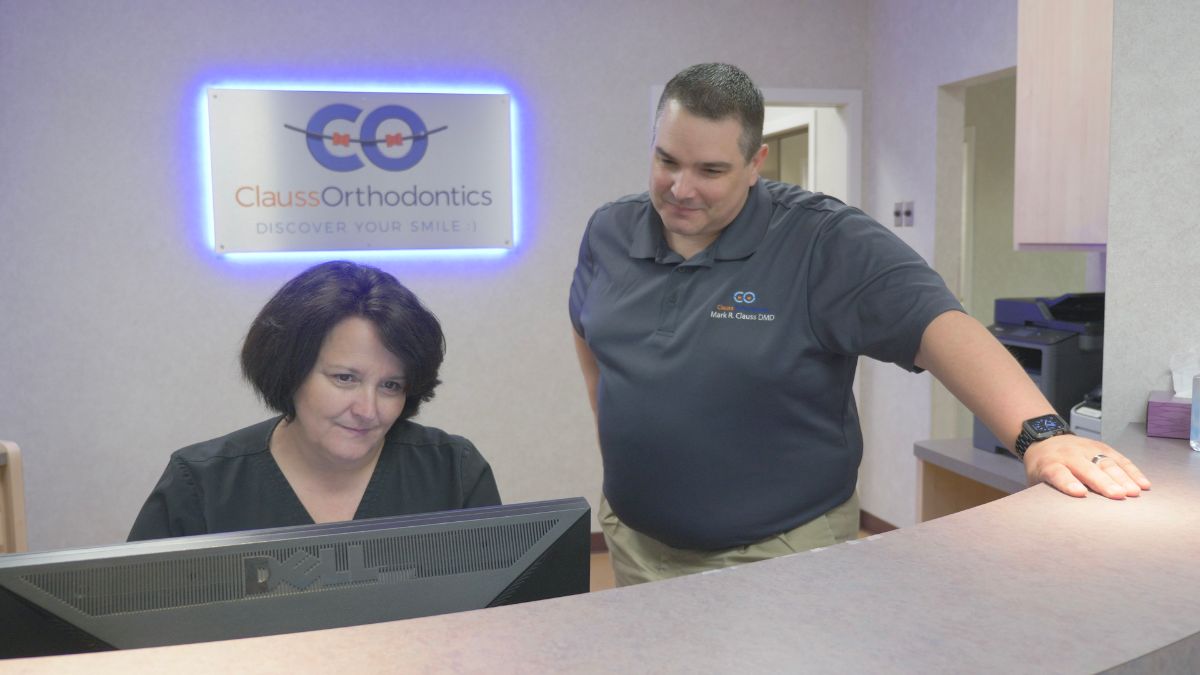Over recent years, orthodontic treatment has gone through some major changes, giving patients more options than ever when it comes to achieving a healthy, confident smile. Using state-of-the-art technology and different types of braces, Dr. Clauss and his expert team are able to successfully treat a multitude of orthodontic issues, including:
- Crowded teeth
- Gaps between teeth
- Protruding teeth
- Overbite
- Underbite
- Crossbite
- Impacted teeth
We do so by using a variety of treatment methods, including traditional braces. Braces continue to be the most common type of orthodontic treatment here at Clauss Orthodontics and have undergone many changes to their design, shape, and even color! The days of bulky brackets are long gone thanks to the smaller, more aesthetically pleasing design that’s used today to efficiently move the teeth.
If you’ve been considering beginning braces treatment to get a straighter smile and improve your oral health, you may be considering all of your options. Your initial consultation with Dr. Clauss will include an orthodontic examination that will help him to determine which treatment option will be the best fit for you and your lifestyle.
To find out more about the different types of braces that are available, how they differ, and how we can use them to give you the smile of your dreams, keep reading below!
A Note About Traditional Braces
Braces are incredibly effective at correcting complex tooth issues and can close gaps and align teeth more quickly and efficiently than other treatments might, which has the potential to shorten your treatment time. Because every case is different, there’s no “one size fits all” answer as to how long treatment will take. However, with metal braces, the average tends to be anywhere from 14-24 months. You’ll begin seeing progress in just a short period of time, which can be very encouraging!
As a patient in traditional braces, you can expect follow-up visits with Dr. Clauss every six to eight weeks or so throughout the treatment process. During your appointments, Dr. Clauss will change the colors that are attached to the brackets as well as replace any worn-out wires. Check-ups are typically pretty quick, and while you may experience some slight soreness after each adjustment, it won’t last long. These check-ups are a critical part of the treatment process and will ensure the best results in the quickest time, so try your best not to miss any of them.
Caring for Your Braces
Traditional metal braces come with some maintenance, which can be a little tricky in the beginning. However, once you get the hang of it, it becomes second nature! A good dental hygiene routine is beneficial for everyone’s oral health, it’s essential for people going through orthodontic treatment. There are quite a few accessories available that have been designed specifically for making cleaning braces at home easier, such as water piks which help rinse away anything that gets lodged in those hard to reach areas, while ortho pics to assist with flossing.
While you’re wearing braces, foods that are sticky or crunchy will need to be avoided in order to prevent any damage to your brackets and wires. This might eliminate some snacks you enjoy, but it won’t last forever! When your braces come off and you see your new beautiful smile, it will all be worth it.

Metal braces
Metal braces are one of the most recognizable symbols of orthodontics, and also the most common treatment option. They’re made of a mix of stainless steel, nickel, and other high-quality metals, which makes the brackets very durable and long-lasting.
Modern metal braces are much more comfortable and lightweight than ever before, and they’re also customizable, thanks to a variety of fun colored bands to choose from! Metal braces from Clauss Orthodontics deliver excellent results and are especially useful in more severe or complicated cases.
Because of the advances in today’s braces, they don’t require some of the more complex technology or expensive equipment that newer treatments do, making them a more affordable option. The overall strength, durability, and cost-effectiveness of traditional metal braces keep them the top orthodontic treatment, year after year.
Ceramic braces
Also known as clear braces, tooth-colored braces, or esthetic braces, ceramic braces function in much the same way as metal braces, with the added benefit of semi-translucent or tooth-colored ceramic brackets. While ceramic braces are nearly the same size and shape as metal braces, they blend in better with a patient’s natural smile for a more subtle straightening option.
Although ceramic braces are tough, the material they’re made of can be prone to chipping or cracking. Since metal braces are more tolerable of pressure than ceramic ones, they may be a better choice for patients who have more severe corrections that need to be made.
Ceramic brackets are usually slightly more expensive than metal braces, as well. Since they can be more costly and are more prone to damage, Dr. Clauss typically recommends ceramic braces for adults and older teens. That being said, ceramic braces can be a great option for many patients. When paired with clear, white, or tooth-colored wires and elastic ties, they’re an incredibly subtle and efficient way to straighten smiles!

Braces to work with every smile at Clauss Orthodontics
Here at Clauss Orthodontics, we believe that every smile is unique – therefore, what works for one patient may not be the best fit for another. That’s why Dr. Clauss and his team create personalized treatment plans for each and every patient! Dr. Clauss has the education, skills, and experience necessary to determine the best course of treatment for your unique smile.
If you’re looking for high-quality orthodontic treatment in Watertown, Woodbury, or the surrounding communities, we would love to meet you and discuss how braces can give you the confident smile you deserve! Contact our office today to schedule your FREE in-office or virtual consultation.
